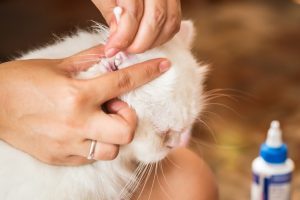Summer is almost upon us. With the warmth and sunshine comes an increase in the number of ear disease appointments. Between swimming, allergies and the combination of heat, moisture, fur and bacteria – warm weather is the perfect recipe for an ear infection.
Ear Infections: The Basics
As opposed to a human ear, a dog’s ear canal has a vertical and a horizontal component. This predisposes dogs to ear infections because debris must work its way upward rather than straight out. Accumulation of ear wax, skin oil and other debris feed the bacteria and fungi (like yeast) that live in the normal ear canal and soon an infection results.
There are a few common causes of ear infections. Allergic skin disease (like food allergies or environmental allergies) is one of the most common reasons dogs come in with ear infections. Other common causes include ear mites, foreign bodies (like grass), hair growth deep in the canal and excessive moisture (from swimming or bathing).
When your dog has an ear infection you may notice an increase in the frequency of head shaking and ear scratching. Some dogs will obsessively rub their heads on the couch or carpet. If you lift the flap of your dog’s ear, you may notice redness, swelling and discharge. Some owners will notice a foul odour emanating from the ear.
Treating Ear Infections:
Most ear infections can be treated by simply having the ear professionally cleaned out followed by daily ear medication at home. A sample of ear discharge is commonly examined under the microscope to assist in selecting medications for home use. After a couple of weeks of home treatment, the ear canals are often rechecked to ensure the infection is gone.
Some dogs, especially those with chronic ear problems, will require regular treatment at home with disinfecting ear washes or some kind of steroid derivative to help with inflammation. These treatment options, in their own ways, help to create an ear environment that is less conductive to yeast and wax production and thus decrease the frequency of infections.
Complications:
For the most part, ear infections are a mild annoyance to both you and your dog. In some cases, severe complications can arise. One complication occurs if the infection reaches the middle ear. This will cause animals to have a head tilt, a lack of balance and unusual back and forth eye movements. A middle ear infection can lead to paralysis of the facial nerve. With proper treatment, a middle ear infection can be resolved but it can take up to 2 months to see an improvement in clinical signs.
Another complication can result from vigorous head shaking as a result of discomfort. The act of shaking can cause a blood vessel in the ear flap to rupture. This leads to bleeding in the tissue of the ear and an aural hematoma forms. It has the appearance of a big firm ball in your dog’s ear. This required drainage, occasionally surgical repair and can lead to permanent scarring.
Ear infections can be smelly, irritating, and uncomfortable. You can help avoid them by drying your dog’s ear well after swimming and bathing and lifting the flaps and getting comfortable looking at your dog’s ears. If you are worried or have questions about routine ear maintenance, cleaning or chronic ear infections, contact Coxwell Animal Clinic and a veterinarian will be happy to assist you.
Happy summer everyone!
Written by Dr. Alana Kestelman




